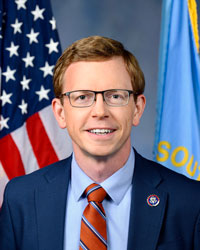Thune, Johnson Lead Colleagues in Urging Department of Justice to Continue Investigation into Beef Industry
“We urge the DOJ Antitrust Division to continue vigilance and where possible, provide updates of findings.”
WASHINGTON — U.S. Sen. John Thune (R-S.D.) and U.S. Rep. Dusty Johnson (R-S.D) today led several of their colleagues in urging Attorney General Merrick Garland to continue the U.S. Department of Justice (DOJ) investigation into the nation’s four biggest meatpackers. Thune and Johnson’s bicameral letter also requested that DOJ provide Congress with updates on its investigation and encouraged ongoing vigilance on this issue.
“It is critically important that producers have fair and transparent markets for the commodities they produce,” the members of Congress wrote. “We urge the DOJ Antitrust Division to continue vigilance and where possible, provide updates of findings.”
The letter was also signed by Sens. John Barrasso (R-Wyo.), Kevin Cramer (R-N.D.), Steve Daines (R-Mont.), Joni Ernst (R-Iowa), Deb Fischer (R-Neb.), Chuck Grassley (R-Iowa), John Hoeven (R-N.D.), and Cynthia Lummis (R-Wyo.) and Reps. Kelly Armstrong (R-N.D.), Liz Cheney, (R-Wyo.), Randy Feenstra (R-Iowa), Ashley Hinson (R-Iowa), Mariannette Miller-Meeks (R-Iowa), and Matt Rosendale (R-Mont.).
Full text of the letter below:
The Honorable Merrick Garland
Attorney General
U.S. Department of Justice
950 Pennsylvania Avenue, NW
Washington, DC 20250
Dear Attorney General Garland:
 We want to bring to your attention our concerns with potential instances of improper and anticompetitive activities in the live cattle and beef industry. Nearly a year ago, on May 22, 2020, the U.S. Department of Justice (DOJ) Antitrust Division sent civil investigative demands (CIDs) to the nation’s four biggest meatpackers. Since that time, the American people have seen no public results from the investigation. In fact, there is no information to even suggest whether the investigation has concluded or is still ongoing. Due to the change in leadership at DOJ since these CIDs were issued and the new allegations of anticompetitive activities since that time, we encourage the Antitrust Division to continue its civil investigation of these entities. Additionally, to the extent allowed by statute, we request that DOJ provide Congress updates on any investigations or ongoing vigilance.
We want to bring to your attention our concerns with potential instances of improper and anticompetitive activities in the live cattle and beef industry. Nearly a year ago, on May 22, 2020, the U.S. Department of Justice (DOJ) Antitrust Division sent civil investigative demands (CIDs) to the nation’s four biggest meatpackers. Since that time, the American people have seen no public results from the investigation. In fact, there is no information to even suggest whether the investigation has concluded or is still ongoing. Due to the change in leadership at DOJ since these CIDs were issued and the new allegations of anticompetitive activities since that time, we encourage the Antitrust Division to continue its civil investigation of these entities. Additionally, to the extent allowed by statute, we request that DOJ provide Congress updates on any investigations or ongoing vigilance.
Cattle producers have faced significant challenges over the last few years. In 2019, a fire at a single beef plant in Kansas, a facility that accounted for approximately 6 percent of our nation’s beef processing capacity at the time, created significant market disruptions. In 2020, the COVID-19 pandemic-related plant closures led to additional processing capacity shortfalls and supply chain disruptions throughout the country. It appears plant labor shortfalls remain an issue today. While black swan events do not always prove wrongdoing, additional attention can reinforce confidence in the system.
Cattle producers, especially small feeders, are again experiencing difficult conditions that are threatening their ability to stay in business. With a tight supply chain, any changes in processing capacity can have a dramatic impact on cattle prices, preventing producers from capturing margin from boxed beef rallies.
It is critically important that producers have fair and transparent markets for the commodities they produce. We urge the DOJ Antitrust Division to continue vigilance and where possible, provide updates of findings.
Thank you for your prompt attention to this request.
Sincerely
###

He’s right. When an industries power becomes concentrated in too few hands, the potential for market disruption grows exponentially and anti-competitive behavior becomes incredibly damaging to a marketplace operating in a healthy manner.